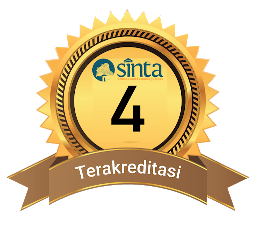Analisis Kesulitan Belajar Siswa dalam Memahami Konsep Kimia Laju Reaksi Kelas XI IPA SMA Negeri 1 Labuapi
DOI:
10.29303/cep.v8i1.9083Published:
2025-05-31Issue:
Vol. 8 No. 1 (2025): Edisi MeiKeywords:
learning difficulties, reaction rate, concept understandingArticles
Downloads
How to Cite
Abstract
This study aims to describe the learning difficulties of students that need to be overcome in understanding the concept of reaction rate chemistry in class XI science SMA Negeri 1 Labuapi. The approach used is a qualitative descriptive approach. The subjects of this study are all students of class XI science of SMA Negeri 1 Labuapi, with samples selected using the nonprobability sampling method of saturation sampling. Data collection was carried out through a closed questionnaire on a likert scale of 5 and interviews. Data interpretation refers to five categories of learning difficulties, namely very high, high, moderately high, low, and very low, which are determined based on simple percentages and tables. The results of the data analysis showed that: 1) Students who experienced difficulties with internal factors included aspects of student ability 38.7%, student interest 37.5%, understanding of reaction rate material concepts 30%, student motivation 27.5%, included in the low category while external factors with aspects of approach/learning model 35%, teaching resources 23% were in the low category, and teachers 17%, class conditions 15% were in the very low category 2) Students' learning difficulties in understanding the concept of reaction rate chemistry that need to be considered are internal factors of student ability indicators (38.75%) and external factors in learning approaches/model indicators (35%).
References
Afrianis, N., & Ningsih, L. (2022). Analisis Kesulitan Belajar Siswa Pada Materi Struktur Atom. Konfigurasi. Jurnal Pendidikan Kimia dan Terapan, 6(2): 102-107.
Aliah., Fitria., Sari, M., & Zubaidah. (2024). Pentingnya Sumber Belajar dalam Pendidikan di Sekolah. Jurnal Pendidikan KITA, 1(1), 42-45.
Arianti (2017). Urgensi Lingkungan Belajar yang Kondusif dalam Mendorong Siswa Belajar Aktif. Didaktika Jurnal Pendidikan, 11(1), 42-62.
Astafani, A., Resmawati, R. F., & Hakim, M. E. L. (2024). Systematic Review: Faktor-faktor Kesulitan Belajar Materi Kimia. Jurnal Inovasi Pendidikan, 18(2), 81-88.
Dhinata, N.M., Laksana, D. N. L. (2017). Kesulitan Belajar Siswa dalam Mata Pelajaran IPA Terpadu.. Jurnal Pendidikan Dasar Nusantara, 2(2), 213-223.
Fadhilah, J. & Anwar, M. (2020). Analisis Miskonsepsi Siswa Kelas XI IPA 1 SMA Negeri 1 Ma'rang pada Materi Pokok Laju Reaksi. ChemEdu (Jurnal ilmiah pendidikan), 1(1), 41-50.
Fantiani, C., Afgani. M.W., & Astuti. R.T. (2023). Analisis Miskonsepsi Siswa Berbantuan Certainty of Response Index (CRI) pada Materi Pembelajaran Laju dan Orde Reaksi. Jurnal Inovasi Pendidikan Kimia, 17(1), 49-53.
Khairunnufus, U., Laksmiwati, D., Hadisaputra, S. & Siahaan, J. (2019). Pengembangan Modul Praktikum Kimia Berbasis Problem Based Learning untuk Kelas XI SMA. Chemistry Education Practice, 1(2), 36.
Lutfianasary, U., & Lestari, D. (2024). Upaya meningkatkan minat belajar kimia peserta didik melalui kemampuan kreatif dan inovatif pendidik. Journal on Education, 6(4), 21265-21271.
Mesra, S. I. R., Sidauruk, S., & Erliza. M (2022). Analisis Kesulitan Siswa dalam Memahami Konsep Laju Reaksi (Systematic Review). Gamaproionukleus Bulan. 2(2), 1-14.
Morrison, G. R., Ross, S. J., Morrison, J. R., & Kalman, H. K. (2019). Designing effective instruction. John Wiley & Sons.
Muderawan, W., Wiratma, I. G. L. & Nabila, M. Z. (2019). Analisis Faktor-faktor Penyebab Kesulitan Belajar Kelarutan. Jurnal Pendidikan Kimia In, 3(1), 17–23.
Mujakir, M. 2018. Pemanfaatan Bahan Ajar Berdasarkan Multi Level Representasi Untuk Melatih Kemampuan Siswa Menyelesaikan Masalah Kimia Larutan. Lantanida Journal, 5(2), 183-193.
Prayunisa, F. (2022). Analisis Kesulitan Siswa Kelas XI dalam Pembelajaran Kimia di SMAN 1 Masbagik. Journal of Classroom Action Research, 4(2), 147-150.
Priliyanti, A., Muderawan, L.W., & Maryam, S. (2021). Analsiis Kesulitan Belajar Siswa dalam Mempelajari Kimia Kelas XI. Jurnal Pendidikan Kimia Undiksha, 5(1), 11-18.
Rumansyah. (2002). Penerapan Metode Latihan Berstruktur dalam Meningkatkan Pemahaman Siswa Terhadap Konsep Persamaan Kimia. Jurnal Pendidikan dan Kebudayaan, No. 35. Tahun ke 8, Maret, h,172.
Safitri, N. C., Nursaadah, E., & Wijayanti, I. E. 2019. Analisis Multipel Representasi Kimia Siswa pada Konsep Laju Reaksi. EduChemia. Jurnal Kimia Dan Pendidikan., 4(1), 1-11.
Simatupang, A. (2021). Hubungan Motivasi Belajar dengan Hasil Belajar Siswa pada Mata Pelajaran Kimia di SMA Negeri 2 Kota Jambi. Jurnal Inovasi Pnedidikan Menengah, 1(3), 199-205.
Sudjono, A. (2010). Pengantar Statistik Pendidikan. Jakarta: Raja Grafindo Persada.
Sugiyono, (2013). Metode Penelitian Pendidikan (Pendekatan Kuantitatif, Kualitatif, R&D). Bandung: Alfabeta.
Author Biography
Afrianti Salahudin, Universitas Mataram
License
Copyright (c) 2025 Afrianti Salahudin, Lalu Rudyat Telly Savalas; Ermia Hidayanti

This work is licensed under a Creative Commons Attribution-ShareAlike 4.0 International License.
Authors who publish with Chemistry Education Practice agree to the following terms:
- Authors retain copyright and grant the journal right of first publication with the work simultaneously licensed under a Creative Commons Attribution License 4.0 International License (CC-BY-SA License). This license allows authors to use all articles, data sets, graphics, and appendices in data mining applications, search engines, web sites, blogs, and other platforms by providing an appropriate reference. The journal allows the author(s) to hold the copyright without restrictions and will retain publishing rights without restrictions.
- Authors are able to enter into separate, additional contractual arrangements for the non-exclusive distribution of the journal's published version of the work (e.g., post it to an institutional repository or publish it in a book), with an acknowledgement of its initial publication in Chemistry Education Practice.
- Authors are permitted and encouraged to post their work online (e.g., in institutional repositories or on their website) prior to and during the submission process, as it can lead to productive exchanges, as well as earlier and greater citation of published work (See The Effect of Open Access).






